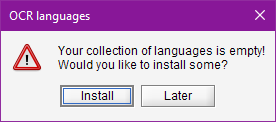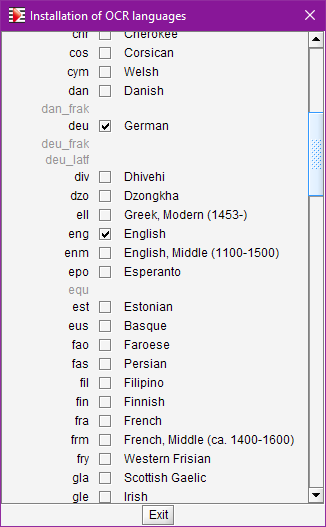OCR languages
new policy in 5.4
Audiveris delegates text recognition to the Tesseract OCR library.
Tesseract OCR is potentially capable of processing text in over a hundred languages.
But, for a language to be effectively supported:
- A specific data file (containing learning materials, a dictionary, etc. for that language) must be installed locally.
- This language must be specified as default, or for the book, or just for the sheet in question.
For example, the processing of an input score using the English language (code: eng) requires that:
- the
eng.traineddatafile is installed beforehand; - the
engcode is specified for the input score.
Table of Contents
No preinstalled languages
Recent history:
-
In version 5.4, no languages were installed by default, except for the old Windows installer without JRE, which preinstalled English.
-
In version 5.5, the old Windows installer without JRE was discontinued and a specific installer, including the JRE, was provided for each operating system (Windows, Linux, and macOS). No languages are preinstalled for these new installers.
At launch, Audiveris checks the list of installed languages and issues a warning if this list is empty. In interactive mode, the following warning dialog is displayed:

We can then:
- proceed immediately with the installation of some languages;
- or simply postpone this action; in the meantime, we can still process the input scores, but the TEXTS step will be ignored.
Installing languages
Prior to version 5.4, the end user was left alone to manually download data files from the Tesseract web site into a local folder. This resulted in recurring errors.1
Starting from version 5.4, Audiveris offers a convenient way to install OCR languages interactively from within the application.
The preferred method is to add languages via the Tools → Languages pull-down menu.
Of course, this feature requires Internet access.
If OK, we get the dialog below:

Here, we can browse through the 100+ languages available on the GitHub Tesseract site, one line per language:
- The language ‘code’ (generally 3 letters) appears on the left
- The full name is on the right
- The checkbox in the middle indicates if the corresponding data file is installed locally
- A gray code, with no checkbox and no full name, can be ignored
To actually download a language, we simply check the related box. The corresponding data file is immediately downloaded to the local target folder and the checkbox is updated once the download is complete.
The local tessdata folder
At launch, Audiveris tries to initialize the Tesseract library with a tessdata folder:
- It first checks if the
TESSDATA_PREFIXenvironment variable is defined and actually points to a directory. If so, this location is chosen.
Note that setting this environment variable is not mandatory, it is meant merely to reuse an existing configuration. - Otherwise, Audiveris looks for a directory named
tessdataunder the OS-dependent Audiveris user config folder.
If this directory does not exist, it is created on-the-fly.
NOTA: this target folder must be writable to actually install any language there.
The About dialog, launched from the Help → About pull-down menu, displays key information about the OCR engine version and the local OCR tessdata folder:

Specifying runtime languages
At runtime, we can specify which languages should be considered by the OCR software for the input image at hand.
This is done via a language specification string – a plus-separated list of language codes, like “fra+eng+ita”:
-
The easiest way is to define this language specification interactively.
Using theBook → Set book parametersmenu, we can make specifications at the global level, book level and even individual sheet level. -
The default (global) specification is determined by the application constant
org.audiveris.omr.text.Language.defaultSpecification, whose initial value iseng.
So, we can also modify this default directly by changing the constant value:- either interactively (using the
Tools → Constantsmenu) - or in batch (using something like
-constant org.audiveris.omr.text.Language.defaultSpecification=ita+eng).
- either interactively (using the
NOTA: Specifying too many languages for a given book or sheet will slow down the recognition task and may increase the number of false recognitions.
So, let us be as specific as possible.
-
Most frequent confusion cases:
- Tesseract program vs. Tesseract library (linked by Audiveris)
- TesseractLSTMmodel vs.legacymodel (the one needed by Audiveris)
- Version of Tesseract language files to be downloaded (4.x)
-TESSDATA_PREFIXenvironment variable (pointing to the local tessdata folder) ↩